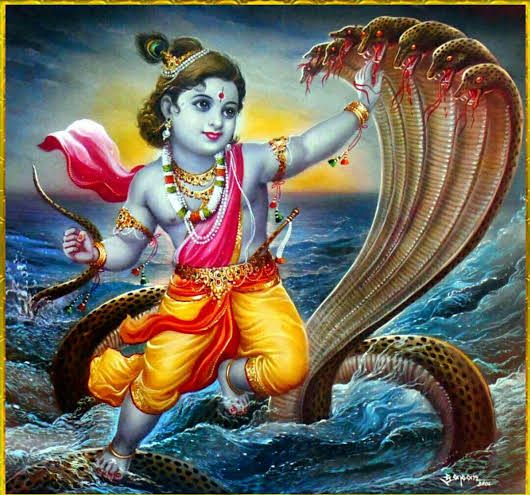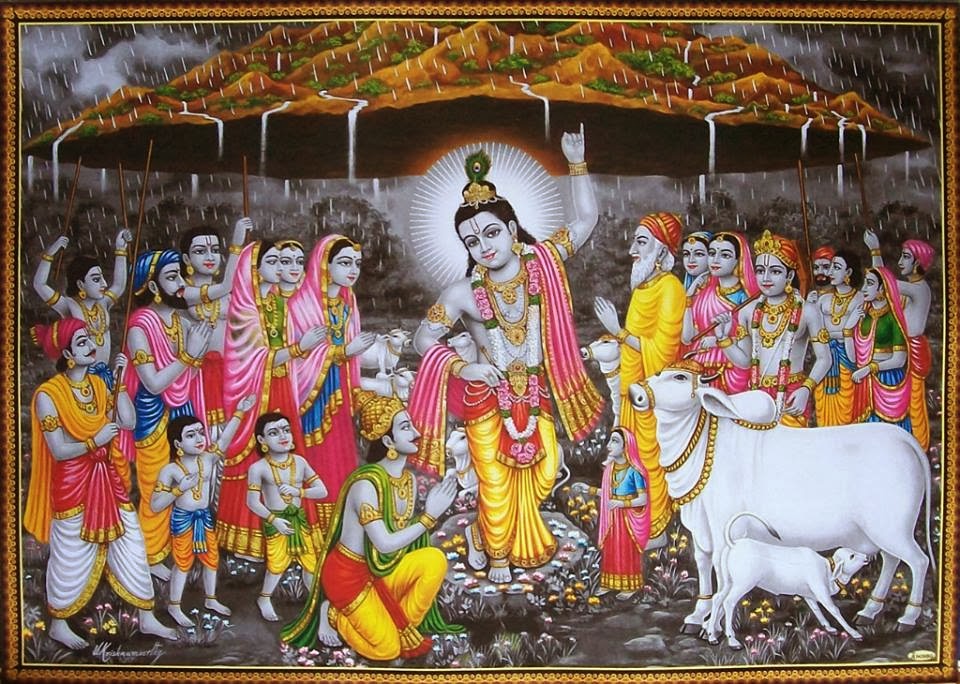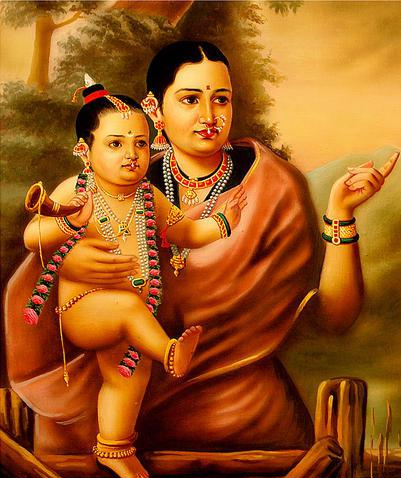When was Krishna born? Do I hear you saying on the Night of Janmashtami?
Well….let’s start again. When was Krishna really born?
No idea what I’m talking about? Ok…let me give you a background.
Anyone growing up in India would’ve heard tales about the birth of Krishna.
About that momentous night when a little baby boy was born to Devki and Vasudeva and how the prison gates miraculously burst open allowing Vasudeva to cross the raging waters of the Yamuna and carry the little Krishna to the safety of Yashoda’s home, away from the the wrath of his uncle Kamsa.
And then there are those endearing tales about bal-krishna, makhan-chor, govardhan-giri-dhari, kalia marthan and so on , describing the exploits of little Krishna in Vrindavan.

The birth of Krishna is directly associated to the birth of these stories. So how did these stories begin?
Tracing Krishna’s roots
The Vedas are the fountainhead of many of India’s pantheon of gods and goddesses. They also happen to be the oldest surviving liturgical texts of the world.
There is no Krishna (as we know him) in the Vedas.
In fact, Vishnu (Krishna is regarded as his avatar) himself, is a minor deity in the Vedas.
“Krishna appears as a seer in the Rigveda. Reference to Krishna is also found in the Chandogya Upanishad where he appears as a disciple of Sage Ghora Angirasa. But it cannot be said whether he is the same Krishna who is the God and Avatara in later texts.
The Mighty Lord of the Vedic corpus is infact Indra followed by Varuna. (These two pale into oblivion in later times – with the rise of Shiva and Vishnu. The rise and fall of these gods makes for a fascinating story in itself…but more on that some other time!) For the moment, let’s return to Krishna.
After the Vedic phase, we have the phase of the Epics – the Ramayana and the Mahabharata. Two of India’s glorious evergreen stories.
It is here that Krishna makes a grand entry!
One of the most important characters in the Mahabharata, he is friend to Arjuna, nephew to Kunti, brother to Draupadi, advisor to all. The Epic gives him divine status.

But there is no story about baby Krishna in the Epic either!
Think about it…Krishna is an adult all through the story.
In our search for baby Krishna…we must push forward to the next phase in time.
To the next phase of literature – The Harivamsha (an appendix to the Mahabharata) and the Puranas. Most significantly the Bhagwat-Puran.
This is the phase where stories of baby Krishna abound. It is also here that the idea that Krishna is an avatar of Vishnu takes root (the idea of avatar in itself is quite a unique and interesting idea!)
All his exploits of stealing butter, troubling the gopis, fighting with Kalia the serpent and so on are woven in these texts.
So you see…it is much like a writer trying to create a back-story for a popular character…in this case, the popular character being Krishna from the Mahabharata.
And when we finally arrive at a baby Krishna, so endearing is that image and so heart-warming are those stories, that they continue to thrive centuries after they were written!

Yes…so Krishna comes into existence quite in reverse order – from nothing in the Vedas to adult in the Epics to child in the Puranas!
As a writer, what I find most intriguing about this journey of the gods is how great devotion, unflinching faith, deep love – everything from bhakti to politics, television entertainment to liberation – just about all of it – has been the fall-out of the imagination of writers!
Valmiki or Vyas, Kamban or Tulsidas – their stories and words wield much power even centuries after they wielded their pens (not exactly pens then…but anyway!) That’s the power of a good story!
Anyway…returning to Krishna again…how did this transformation take place?
How does Krishna go to becoming one of the most popular deities of the Hindu pantheon? What was the tipping point?
The answer lies in a great movement that swept India by storm.
The Bhakti Movement
The Bhakti movement began in South India in the 6th century CE and moved northwards thereafter, sweeping all across the land.
It challenged the traditional idea of sacrifice as a means to liberation, questioned the basis of empty rituals, raised issues of gender-biases in religion, protested against the domination of upper castes, provided a voice to the marginalized and the ostracized.
This movement catapulted Krishna to hero-worship and iconic status. A position he enjoys to this day.
“The Bhakti movement had a great role to play in the spread of Krishna as a deity when his pranks, his romance, his escapades etc were all depicted through numerous songs, bhajans and hymns. Devotees like Mirabai, Namdev and Andal and their simple devotional poetry made Krishna a household deity.
Author and Visiting Faculty for Comparative Mythology at Mumbai University
Whether it was Meera in the north, Andal in the south or Tukaram in the centre, a wave of Krishna-craze gripped the people.
A Cult Classic
Krishna soon becomes a cult hit. And why not? He had everything it took to create mass appeal.
- The baby Krishna and his pranks appealed to mothers and children;
- The divine Krishna and his philosophy in the Bhagwad Gita appealed to the spiritual-minded.
- To the romantic, Krishna`s romantic escapades are the stuff of legends.
- To the rebel, Krishnas killing of his uncle Kamsa (one of the only instances in Indian mythology of a child killing a father-figure) makes him a bold hero as compared to Rama who obediently follows his father.
- Krishna’s street-smartness and willingness to bend rules where necessary, makes him a hero to a new aspiring class that was tired of the same old. Krishna does not think much of white-lies or using deceit if it was necessary to win the war. These qualities make him more real than Rama who was anything but this!
Endearing and Entertaining – Krishna really had it all!
“Krishna has all the characteristics of Indra, who was the Suprme deity of the Vedas. Relieving humans from distress, killing demons and so on, made Krishna superior to the Vedic Indra. Krishna seems to be a folk hero who got treated as divine later. Vishnu’s benevolent aspect was favourable for subsuming Krishna in the Vishnava fold. As a result, the growing Krishna cult was assimilated into the Vaishnava cult to continue the Vedic faith against hetrodox systems.”

And so it was that a little cherubic baby (Krishna) ousted the King of the Gods (Indra) to acquire cult status.
With the help of some imagination, a terrific movement and a whole lot of stories!
While the idea of God (who is widely regarded as a father-figure) being a cherubic little baby, may seem odd and contradictory to the concept of an all-powerful God, in my opinion, therein lies the true beauty of India.
There is no one formula. No singular way. No gospel truth.
While one can imagine God as the father, the other can imagine God to be a baby and a third may see him as friend. While many like Meera, Andal and Akka Mahadevi imagined God to be husband, Shankara imagined God to be an essence.
In this land of plurality…everything is possible!
And May it always remain so!
Coming up next week… More on Krishna…
Why is Krishna Blue?
Ever wondered why Krishna looks blue in comics, stories and pictures? Krishna actually means black. Krishna was dark and hence the name. So how does he become blue?

So why and how does Krishna suddenly become blue?
Coming up next weekend is my first guest post on the blog written by Tamil mythology expert Sumathi Sridhar titled So..why is Krishna Blue?
Follow the site, subscribe to the newsletter…you know the drill…stay tuned for more.
PS – How you can use this story
- If your child studies History at school, you can use it to introduce the Idea, History and Impact of the Bhakti movement;
- If you have a younger child, you can use it as a window to explore stories about Krishna through time and analyse why those stories were created;
- For children of any age, you can use it to discuss the idea of God – what it means to different people, how it may have begun, the rise and fall of different ideas of God, etc.
- Those who enjoy literature can ponder over the potential of the written word to create everlasting myths, beliefs and legends.
This Janmashtami, as you enjoy the 56 bhog and dahi handi celebrations, take a moment also to ponder about how all this fanfare might once have begun!
———–
Keneth Antal
March 19, 2019 - 11:20 pm ·as I website owner I conceive the subject matter here is very excellent, regards for your efforts.
Mallika Ravikumar
March 24, 2019 - 6:50 am ·Thank you so much for your appreciation.